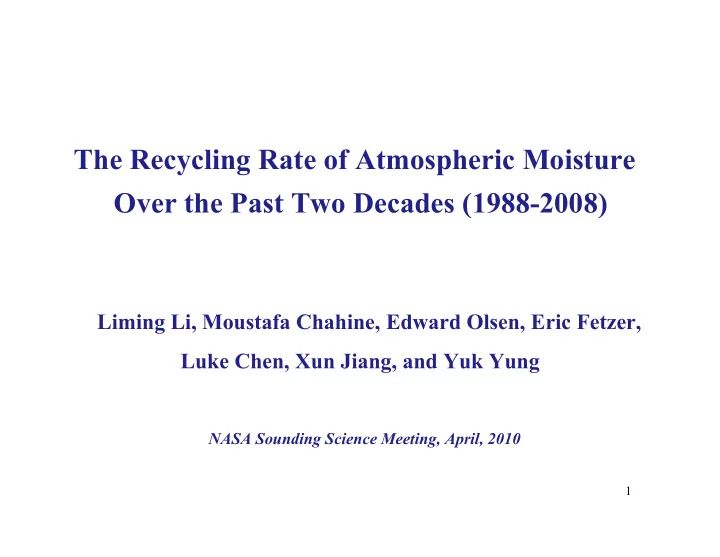

The Recycling Rate of Atmospheric Moisture Over the Past Two Decades (1988-2008) Liming Li, Moustafa Chahine, Edward Olsen, Eric Fetzer, Luke Chen, Xun Jiang, and Yuk Yung NASA Sounding Science Meeting, April, 2010 1
Overview Motivation Data Revisit Previous Studies New Results Conclusions 2
Motivation Recycling rate (or residence time) of atmospheric moisture is an important index of climate change. How does recycling rate change in response to global warming? 3
Background Definition R = P W (Chahine et al., 1997) R: recycling rate; P: precipitation; W: column water vapor � = � P P ( Stephens and Ellis, 2008) � R R � � P P � � W W � W W � > 0 or > 1 when > � W W � R R � P P � < 0 or < 1 when < � W W � R R � P P � Some model studies suggest � R R < 0 or < 1 A recent observational study ( Wentz et al., 2007 ) suggests � > 0 or > 1 � R R 4
Data Sets Precipitation (P) GPCP (V2 and V2.1) 2.5º × 2.5º global monthly precipitation (1988-2008) SSM/I (V5) 0.25º × 0.25º oceanic monthly precipitation (1988-2008) Column Water Vapor (W) SSM/I (V5) 0.25º × 0.25º oceanic monthly precipitation (1988-2008) AIRS (V5) 1º × 1º global monthly data (2002-2008) NVAP 1º × 1º global monthly data (1988-2001) Temperature (AT and SST) NCEP2 2.5º × 2.5º global monthly atmospheric temperature (AT) (1988-2008) NOAA 2º × 2º monthly sea surface temperature (SST) (1988-2008) 5
Revisit Previous Study (Precipitation) Based on the old version data sets ( GPCP V2 and SSM/I V4 ), Wentz et al. (2007) got (1988-2006) (globe) = 1.4 ± 0.5%/decade � � P P ≥ 0 or ≥ 1 � R R (ocean) = 1.2 ± 0.4%/decade � W W Examination with new version data sets ( GPCP V2.1 and SSM/I V5 ) � P P 1.3 ± 0.6%/decade GPCP V2 GPCP V2.1 0.3 ± 0.5%/decade GPCP V2.1 - 0.3 ± 0.6%/decade + SSM/I V5 � ? 0 or ? 1 � R R 6
Water Vapor (W) Correlation of T and W SST & W 0.72 Ocean: 700-mbar T & W 0.61 Land: 700-mbar T & W 0.55 * Correlation over ocean > Correlation over land (Clausius-Claperyron law). * Lack of long-term continuous water vapor (W) over land make it hard to 7 estimate recycling rate (R) over the whole globe (ocean and land).
Precipitation Over Ocean * High-quality data sets over ocean between 60 ° N and 60 ° S. * Coast regions are excluded from this study. Nino 3.4 Index GPCP V2.1 0.07±0.7%/decade Raw Data SSM/I V5 -0.6±1.5%/decade GPCP V2.1 0.13±0.6%/decade Removing ENSO SSM/I V5 -0.4±0.9%/decade * Precipitation is correlated with ENSO signals. 8 * No significant trend in ocean-average precipitation during 1988-2008.
Water Vapor Over Ocean 0.9±0.5%/decade raw data Water vapor trend over ocean remove ENSO 1.0±0.4%/decade * A positive trend in ocean-average water vapor during 1988-2008. ( per decade , roughly same as per decade 0.3 kg m 2 0.4 kg m 2 9 during 1988-2006 (Santer et al., 2007)).
Recycling Rate Over Ocean Trend of Recycling Rate (R) P (GPCP) / W (SSM/I) -0.9±0.7%/decade Raw Data P (SSM/I) / W (SSM/I) -1.4±1.3%/decade P (GPCP) / W (SSM/I) -0.9±0.6%/decade Removing ENSO P (SSM/I) / W (SSM/I) -1.2±0.9%/decade * A weak negative trend in ocean-average recycling rate, which means: 10 � R R < 0
Spatial Pattern (Precipitation) SSM/I V5 P GPCP V2.1 P Time-mean State Linear Trend * Positive trend in strong precipitation regions (ITCZ). * Negative trend in some weak precipitation regions. 11
Spatial Pattern (Water Vapor) SSM/I V5 Water Vapor Time-mean State Linear Trend 12
Spatial Pattern (Trend Comparison) (A) Precipitation trend; (B) Water Vapor trend; (C) Atmospheric temperature trend; (D) SST trend. * Trends in precipitation and water vapor have roughly same spatial patterns. * Comparing with atmospheric temperature, SST trend pattern is more close to P/W. 13
Spatial Pattern (Recycling Rate) P (GPCP) / W (SSM/I) P (SSM/I) / W (SSM/I) Time-mean State Linear Trend * Positive trend in high recycling-rate areas over tropical ocean (ITCZ). 14
Spatial Pattern (Recycling Rate) ∆ R/R from P (SSM/I) & W (SSM/I) ∆ R/R from P (GPCP) & W (SSM/I) * Ocean-Average: � R R < 0 15 *However, for ITCZ area: � R R > 0
ITCZ Area (Definition) SSM/I V5 GPCP V2.1 ITCZ Low Precipitation Area 16
ITCZ Area (Precipitation) Raw Data Removing ENSO Precipitation Trend GPCP V2.1 3.1±1.5%/decade ITCZ area: SSM/I V5 2.5±1.6%/decade GPCP V2.1 -6.5±4.5%/decade Low-P area: SSM/I V5 -7.7±5.6%/decade * Strong El Nino (97-98) critically affects precipitation. 17 * Positive precipitation trend in ITCZ; Negative trend in low-P area.
ITCZ Area (Water Vapor) Water Vapor Trend ITCZ: 1.5±0.6%/decade Low-P area: 0.6±0.6%/decade * Positive water-vapor trend in ITCZ area. 18 * Strong El Nino events (i.e., 1997-98) affects water vapor in low-P areas.
ITCZ Area (Recycling Rate) Removing ENSO Raw Data Recycling Rate Trend P(GPCP)/W(SSM/I) 1.7±1.1%/decade ITCZ area: P(SSM/I)/W(SSM/I) 0.8±1.3%/decade P(GPCP)/W(SSM/I) -5.8±3.5%/decade Low-P area: P(SSM/I)/W(SSM/I) -8.7±5.1%/decade * Weak positive recycling-rate trend in ITCZ area and negative trend in low-P area. 19 * Strong El Nino (i.e., 1997-98) affects tropical recycling rate.
Conclusions New Precipitation (P) data suggest a much weaker trend. Lack of long-term continuous water-vapor (W) data over land make it hard to estimate global recycling rate. Over the ocean, consistence between GPCP V2.1 and SSM/I V5 suggests a negative trend in spatial-average recycling rate (R). However, positive trends of P, W, and R are detected in high-P area (ITCZ), and negative trends of P and R are detected in low-P area. It suggests that extreme weather intensified along global warming during the past two decades. Strong El Nino (i.e., 1997-98) critically modify hydrological cycle over tropical region (need more observations). 20
Acknowledgement SSM/I GPCP (David Bolvin and Phillip Arkin) NVAP (Janice Bytheway, Tomas Vonder Haar, and John Forsythe) NCEP2 and NOAA 21
Recommend
More recommend